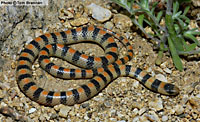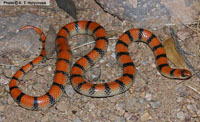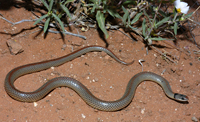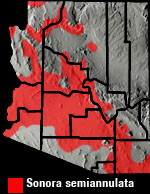Online Field Guide to The Reptiles and Amphibians of Arizona



Maricopa County, AZ
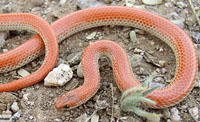 Pinal Co., AZ |
||
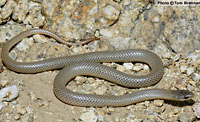 Maricopa Co., AZ |
| GROUNDSNAKE Sonora semiannulata |
Mildly Toxic Saliva
|
| DESCRIPTION: A small (up to 483 mm or 19″ in total length) snake with extremely variable coloration and markings. Several different color/pattern morphs can be found at the same locality. Base color can be light tan, cream, gray, blue-gray, or orange-red. Pattern morphs include plain, plain body with a black or gray head, a thin orange-red dorsal stripe, an orange back, black crossbands over an orange back, and black crossbands over a plain back. Black crossbands may or may not cross the underside. In banded specimens with a red back the black bands contact the red distinguishing this snake from the similar looking Western Shovel-nosed Snake. Each lateral scale usually has a dark spot on the anterior edge distinguishing this snake from the Variable Sandsnake. The underside is plain cream distinguishing this snake from our black-headed snakes which have orange-red coloration on the belly. The scales are smooth and shiny and the pupils are round.
DISTRIBUTION: This snake is distributed across western and most of southern Arizona at elevations ranging from near sea level along the Colorado River to about 5,000′. HABITAT: It is found in a wide variety of communities including Arizona’s desertscrubs, Semidesert Grassland, Interior Chaparral, Plains and Great Basin Grassland, and the lower reaches of the woodlands. It occupies steep rocky canyons and slopes, gentle bajadas, foothills, and low valleys. This harmless snake is commonly encountered in yards in the Phoenix metropolitan area.BEHAVIOR: This ground dweller can be active at any time of the day or night in mild conditions. Desert populations are primarily nocturnal during the hot summer months. It is usually dormant during the cold months (roughly late November into February).DIET: The Groundsnake eats a variety of insects, spiders, scorpions,centipedes, and lizards. REPRODUCTION: Males combat each other for access to females during mating season. Mating takes place in spring and a clutch of up to six eggs is laid in late spring or early summer. By Thomas C. Brennan Bartlett. 2000. Snakes of North America: Western Brennan, T. C., and A. T. Holycross. 2006. A Field Guide to Amphibians and Reptiles in Arizona. Arizona Game and Fish Department. Phoenix, AZ Brennan, T. C., and A. T. Holycross. 2005. A Field Guide to Amphibians and Reptiles of Maricopa County. Arizona Game and Fish Department. Phoenix, AZ Degenhardt, W. G., Painter, C. W., and Price, A. H.. 1996. Amphibians and Reptiles of New Mexico. University of New Mexico Press. Albuquerque. Fowlie. 1965. The Snakes of Arizona. Azul Quinta Press, Fallbrook, California Stebbins. 1985. Western Reptiles and Amphibians. Houghton Mifflin. New York, |
|
Visit Partners in Amphibian and Reptile Conservation:


HOME
Copyright © 2023, Arizona Game and Fish Department. All rights reserved.
If you make use of the textual contents of this site in reports, publications, etc. please cite and credit the author(s) and photographer(s). All photos on this website are copyrighted. However, those found in the species account section may be used for any noncommercial scientific, educational, or conservation purposes provided that photographs are not altered and continue to bear the copyright symbol and name of the photographer. Please contact the photographer regarding commercial use of copyrighted photographs.










